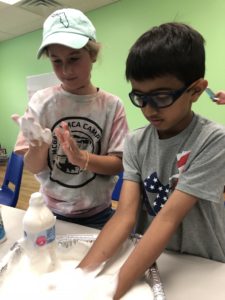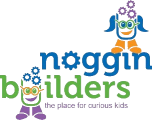One of our absolute favorite experiments here at Noggin Builders is Elephant Toothpaste. Not only is the chemistry fascinating, but the chemical reaction it produces never fails to delight all ages!
You will need:
-16-20 oz plastic bottle, empty and clean
-1/2 cup of 20 volume (6% solution) hydrogen peroxide
-a funnel
-1 tbsp of dry yeast
-3 tbsp of warm water
-liquid dish soap
-food coloring (optional)
-a cup for mixing
-a spoon for mixing
-a messy tray or empty sink
Safety precaution: hydrogen peroxide can irritate or burn eyes and skin, so an adult should supervise this experiment. In case of contact, wash/flush with water immediately.
Begin by using the funnel to carefully pour the hydrogen peroxide into the bottle. If desired, add food coloring.
Squirt approximately 1 tablespoon of liquid dish soap into the bottle, gently swishing the bottle to mix. Be careful not to create bubbles in the bottle!
In your mixing cup, combine the warm water with the yeast and stir until yeast is fully dissolved.
Place your bottle in a messy tray or sink, and then pour the yeast mixture into the bottle to create the chemical reaction!
It’s safe to touch the chemical reaction! What do you notice about it? What does it feel like?
The chemical reaction in elephant toothpaste occurs between the yeast and the hydrogen peroxide. Hydrogen peroxide is a chemical that breaks down into oxygen and water. In this experiment, the yeast acts as a catalyst, which means it helps to remove the oxygen from the hydrogen peroxide. Since we added soap, this creates a foam made of water, soap, and oxygen-filled bubbles! The warmth you feel in the foam is caused by the chemical reaction as well. When the yeast takes away the oxygen, energy is transferred, which gives off heat!
Next, try the experiment again, but change the quantities of the materials. For example, what happens if you don’t put in soap? What happens with more hydrogen peroxide?
Note for parents: Elephant toothpaste is safe to rinse down the drain when finished.


